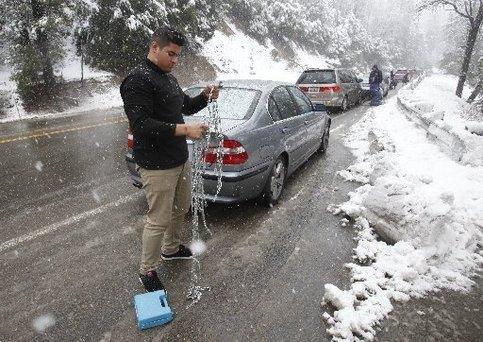Written by Dave Henderson, Park Ranger
YOSEMITE – Winter is sneaking up on us and we all know the climate around here changes pretty fast.
Greetings everyone from your friendly Yosemite Traffic Management Office!
In anticipation of winter each year, I put out winter related information for new and seasoned employees alike. It’s always a good refresher to review and print up as reference material before the snow begins to fall.So here we go!
CHAIN CONTROL:
All vehicles MUST CARRY CHAINS or other approved traction devices in the mountains during winter conditions. The speed limit in chain control zones (after the chain control checkpoint) is 25 MPH until you leave the controlled zone.
Yosemite National Park imposes and posts the following restrictions depending on conditions –
R-1: Chains are required on all vehicles except passenger vehicles and light-duty trucks under 6,000 pounds gross weight and equipped with snow tires on at least two drive wheels. Chains must be carried by vehicles using snow tires. All vehicles towing trailers must have chains on one drive axle. Trailers with brakes must have chains on at least one axle.
R-2: Chains are required on all vehicles except four-wheel-drive vehicles under 6,500 pounds gross weight and equipped with snow tires on all four wheels. Chains for one set of drive wheels must be carried by four wheel-drive vehicles using snow tires. 4×4’s over 6500 lbs MUST ‘chain up’ – (examples depending on equipment – H1 Hummers, Expeditions, some one ton dually pickups, etc.)
R-3: Chains are required on all vehicles without exception. (There is no such thing as “an exempt vehicle”).
SOME HANDY INFO:
• What are the dates for the chain law? California does not have any specific dates when vehicles are required to carry chains. When the road is posted with a sign requiring chains, all heavy-duty vehicles (over 6,500 pounds gross weight) must be equipped with chains mounted on the tires in order to proceed. Depending on the severity of road conditions, some vehicles (passenger cars, 4-wheel drive vehicles with snow tires) may not be required to install chains at that point. The exceptions will be posted on the sign.
• Are “all-weather” or “all-terrain” tires the same as “snow” tires? They may be. Snow tires have the designation “Mud & Snow” or an abbreviation such as “M-S,” “M+S,” or “M/S” marked on the tire sidewall. Tires without this designation are not considered snow tires. Snow tires must also have at least 6/32-inch (3/16″) of tread depth (about 1/2 of the original tread depth).
• If I have 4-wheel-drive, do I need to carry chains? Yes. Even though weather conditions may not warrant the use of chains on 4-wheel-drive vehicles at a particular time, to enter a chain control area, you must have a set of chains (for one drive axle) for your vehicle in your possession. If conditions worsen or you have trouble controlling your vehicle, you must stop and install the chains.
• If I have snow tires, do I need to carry chains? Yes. Even though weather conditions may not warrant the use of chains on passenger vehicles equipped with snow tires at a particular time, to enter a chain control area, you must have a set of chains (one pair) for your vehicle in your possession. If conditions worsen or you have trouble controlling your vehicle, you must stop and install the chains.
• If I have studded snow tires, do I need to carry chains? Yes. Studded snow tires are not considered tire traction devices and may not be used in lieu of chains.
• Is “all-wheel drive” the same as 4-wheel drive? Yes. Even though all-wheel drive systems may differ mechanically from conventional 4- wheel drive systems, for the purposes of chain control, all-wheel drive is considered the same as 4-wheel drive.
• Do I have to put on chains when I am towing a trailer? Yes, always.
• Even if I have 4-wheel drive? Yes.
• Do I have to put chains on the trailer? You must have at least one axle chained if the trailer is equipped with brakes.
QUESTIONS REGARDING CHAIN CONTROL OR ROAD CONDITIONS IN THE PARK?
Call the recorded line at: (209) 372-0200 or the Traffic Management Office at: (209) 372-0600
CHECKLIST BEFORE HEADING OUT ONTO THE ROAD:
Brakes in good working order?
Tires have good tread depth?
Tire pressure correct?
Windshield wipers working correctly?
Antifreeze levels, heaters, defrosters working per factory specs?
Lighting (headlamps, turn signals, brake lights) functioning?
SUGGESTED ‘ONBOARD’ SUPPLIES FOR WINTER ROAD CONDITIONS:
Chains, Cables or Spiders !!! (depending on your vehicle type)
Windshield de-icer
Ice scraper
Blanket(s)
Flashlight (batteries fresh?)
Bottled water
Non perishable food (i.e.: energy bars)
Broom or snow brush
Small shovel
Towel or burlap sack for traction if needed
Cell phone? (Keep cell phone with you when exiting the car to install chains)
Extra key in packet or hidden on car? (Lock-outs occur frequently while installing chains)
Flares, reflective triangles for emergency situations
Small first aid kit for cuts and scratches
Remember to stay safe and drive to meet the conditions – Watch out for snow clearing equipment – Give our plows a wide berth and slow down! Ice and snow driving require enhanced awareness, driving skills and a bit more time.
Here’s to an accident-free winter season!
Dave Henderson is a Yosemite Park Ranger and Traffic Management Supervisor, Division of Visitor & Resource Protection



